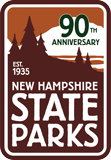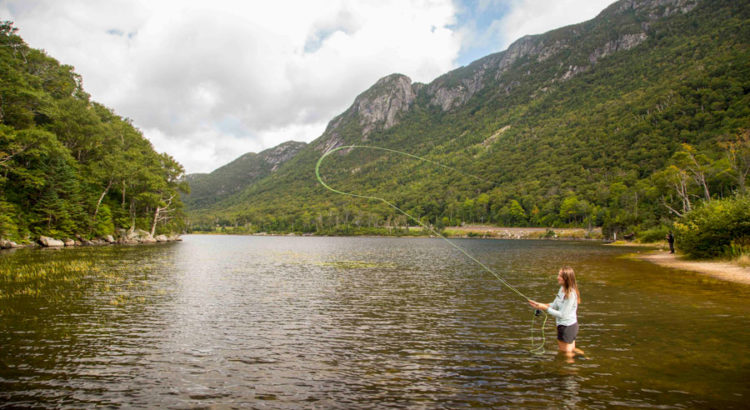By: Brian Donovan, Interpretive Ranger at Franconia Notch State Park
Salvelinus fontinalis, (Mitchill, 1814)
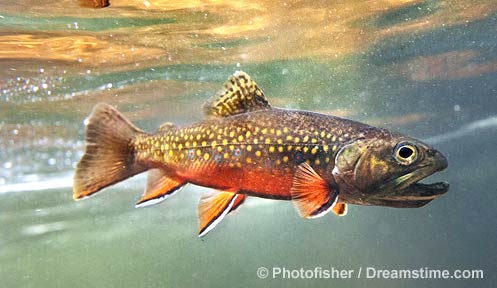
Humans have always been fascinated by fish. They are truly marvelous creatures. Our love affair with these animals is ancient. For as long as our species has been around, we have interacted with fish in a variety of ways.
Perhaps my favorite way to interact with fish is to simply observe them. Here in Franconia Notch State Park, we have three different types of trout species. This blog is meant to get you, the visitor, better acquainted with my favorite species of trout, the Eastern Brook Trout.
Three species of trout live in Franconia Notch State Park, they are the Eastern Brook Trout, the Rainbow Trout, and the Brown Trout. Both the Rainbow Trout and the Brown Trout are nonnative trout species. These two fish were introduced to Franconia Notch State Park many years ago.
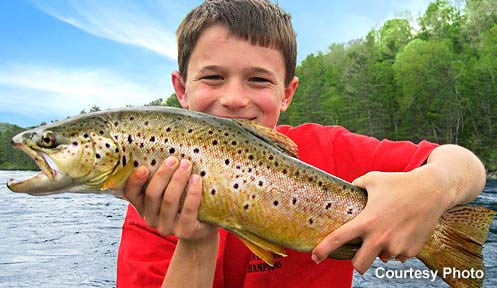

The Rainbow Trout is native to the West Coast of the United States while the Brown Trout is native to Europe.
The Eastern Brook Trout is native to the White Mountains of New Hampshire and much of the East Coast of the United States. This fish is an amazing local specimen, it is one of my favorite types of wildlife found in Franconia Notch.
Anglers often refer to Eastern Brook Trout as “Brookies”. The Eastern Brook Trout is a hardy species, one that is well adapted for life in cold mountain streams. The Eastern Brook Trout is a top predator in many of the local water bodies here in the park. This trout primarily feeds on insects and aquatic insect larvae.
If you are hiking on some of the trails in Franconia Notch State Park, several of the tributaries that feed Lonesome Lake are full of juvenile Brook Trout.
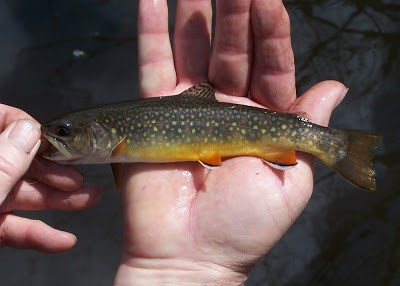
Juvenile Brook Trout with visible Parr Marks. Parr Marks are the dark patches of pigmentation located on either side of the fish. Many juvenile salmonids have Parr Marks.
Located below are some Brook Trout fast facts. These facts are intended to provide you, the visitor, with some further information regarding this fish.
Brook Trout Fast Facts
- Adult Brook Trout range from 6 to 13 inches in length.
- These fish thrive in cold, freshwater streams.
- Brook Trout do best in streams that have lots of tree cover, vary in terms of flow and conditions, contain down woody debris, and possess a gravel bottom.
- Brook Trout also live in cold, deep water lakes. In Franconia Notch State Park, Echo and Profile lakes support reproducing populations of Eastern Brook Trout.
- Brook Trout primarily feed on aquatic invertebrates. Mostly insects.
- Spawning occurs from October to December.
- Adults can spawn multiple times. This is known as iteroparity.
- Eggs are deposited in shallow gravel nests. These nests are known as redds.
- Brook Trout are excellent indicators of strong water quality and healthy freshwater systems.
- If Brook Trout are found in your backyard stream, you and your neighbors are doing something right!
Why should you care about this important fish?
- This fish is awesome. It’s a powerful and dynamic freshwater predator.
- The Brook Trout is a prized sport fish for many anglers.
- The Brook Trout is an excellent indicator of good water quality.
- This fish plays an important role in New England freshwater ecology.
- The Brook Trout is also the official freshwater fish of New Hampshire.
- Brook Trout are highly sensitive to pollutants and improper human development. Populations of Brook Trout have plummeted in certain parts of the Appalachian Mountains. With a continued emphasis towards conservation, state, local, federal, and private agencies are working hard to bring back the Eastern Brook Trout.
- Do your part to keep this amazing predator around by volunteering with wildlife agencies, limit the use of artificial fertilizers and pesticides on your property, and stay current on issues concerning the Eastern Brook Trout.

If you are planning to fish in Franconia Notch State Park, please adhere to all regulations and purchase a fishing license.
Fishing in Franconia Notch State Park
- If you are going fishing in the state of New Hampshire, state law requires that you purchase a fishing license.
- If you are 16 years of age or older, please purchase a state fishing license if you are going fishing.
- Profile, Echo, and Lonesome Lakes are great places to fish for Brook Trout.
- Profile Lake is fly-fishing only.
- As always, stay current with fishing regulations. A complete list of regulations can be found on the New Hampshire Fish and Game website (http://www.wildlife.state.nh.us/index.html).
- Stay safe, be prepared, and have fun!
My goal with this blog was to teach the public a thing or two about The Eastern Brook Trout. However, I only touched upon a fraction of the available information out there. If you would like to learn more about this fish, or the state park in general, attend one of my programs, post a question below, and get out there!
Further information on the Eastern Brook Trout can be found in local libraries, on the New Hampshire Fish and Game Website, on the U.S. Fish and Wildlife Service website, and the U.S. National Park Service website. On further note, Shenandoah National Park has a great web page on the Eastern Brook Trout.
Have a great summer and fall. I hope to see you out in the park!
